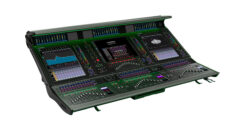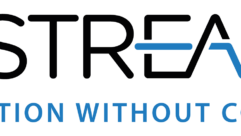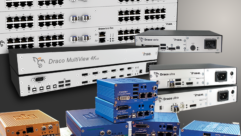
Technology Showcase:
Ethernet Audio Distribution
Feb 1, 2007 12:00 PM,
By Bennett Liles

QSC Rave
Driven by the low cost and availability of Ethernet hardware and the versatility of software configuration, a variety of competing schemes for uncompressed PCM audio distribution on switched Ethernet have surfaced. We are still in the “Beta vs. VHS” stage of Ethernet sound conveyance, but the concept has matured enough that the benefits and best applications of each plan have emerged. In this article, I will list several of the more proprietary methods, and take a closer look at some hardware using those schemes that have been more widely adopted.
COBRANET
The most mature entry in the sound-on-Ethernet arena is Cirrus Logic‘s CobraNet, which, according to the company, has more than a half-million channels installed. The network consists of an audio input module to digitize analog or accept AES sources, an Ethernet switch, a computer running the configuration software, and either a CobraNet breakout box or a device equipped with a CobraNet input module, such as a self-powered speaker or stage snake. One device on the network acts as a conductor to keep all the others synchronized for orderly and timely packet delivery, and traffic may be point-to-point or multicast from one to many. The audio is sent in bundles with up to eight channels per bundle.

Axia AES/EBU Node
CobraNet has progressed through several increasingly capable versions. It typically conveys digital bidirectional signals at 48kHz and exhibits a normal latency of around 5ms in the system. Of course, in applications where the sound is delivered to locations outside of the immediate acoustic environment, this delay is not a factor. Lower latency can be achieved through adjustment in other parameters. Gigabit networks can produce much higher channel capacity, and in CobraNet networks, these are grouped as either multicast or unicast bundles.
The truly beautiful thing about switched Ethernet audio is the ability to add device monitoring/control with applications such as CobraNet Discovery (Disco), which handles these functions through the well-established Simple Network Management Protocol (SNMP).

Biamp AudiaFlex
With all this Ethernet terminology, it is important to remember that we are not discussing Internet-based audio, because these Ethernet sound schemes use only the physical and data link layers of 802.3. Although not limited to big venues, greater numbers of CobraNet networks are in large permanent sound system installations. CobraNet has been implemented for the Olympic games, Super Bowl, and other high-profile events. It is possible for CobraNet audio to share a general-purpose Ethernet network, but many CobraNet equipment manufacturers don’t recommend using a shared 100Mbps network.
ETHERSOUND
In applications requiring very low latency, EtherSound, licensed by Digigram, offers an alternative. Typically exhibiting an extremely low analog input-to-output latency and a pickup of about 1.22µsec for each node added, EtherSound sends out a frame stream from the primary master to the slave devices. In a daisy-chain configuration, one device can loop an upstream signal back to the primary master. Similar to CobraNet, net sync is provided by the primary master module to which all other network devices are clocked. A 100Mbps Ethernet installation can carry 64 channels of bidirectional 44.1/48kHz audio, or combinations of fewer channels with higher-bit-rate sound.

BSS BLU-80
EtherSound also allows embedded configuration, control, and device monitoring. Both CobraNet and EtherSound users are implementing Gigabit Ethernet applications for larger, more sophisticated systems on fiber. For the present, mixed use with general-purpose Ethernet office data on 100Mbps networks is not recommended. Gigabit networks offer dedicated channels for PC and other non-audio data traffic to be used simultaneously with a vastly increased number of audio channels and bit rates.
LIVEWIRE
From Telos Systems and marketed through Axia Audio, its studio audio division, Livewire is interesting because it was developed especially for broadcast applications used with associated playlist/music library control systems.
Livewire offers low latency and high reliability in a proprietary switched Ethernet audio conveyance. Along with audio signals, program-associated data, device control signals, and general-purpose Ethernet traffic can be carried. A useful feature of Livewire is its ability to adjust its packet size to offer two types of signals: LiveStreams with small, fast packets for low-latency live applications, and Standard Streams with larger packets designed for audio file transfers. All Axia devices can use both types, and the company touts its protocol as being compatible with web browsing and other routine office Ethernet traffic.
CUSTOM FLAVORS
Other proprietary Ethernet audio protocols include Aviom‘s A-Net and A-Net Pro for the company’s Pro16 and Pro64 systems, which also have broadcast applications; the low-latency Catalyst stage distribution system from Pro Co Sound; Gibson‘s MaGIC (Media-accelerated Global Information Carrier) with physical layer IEEE 802.3 compatibility; AudioRail‘s time division multiplexing MII protocol; Hear Technologies‘ HearBus; Intelligent Media Technologies‘ SmartBuss; TOA Electronics‘ NX-100 system for paging applications (with compressed audio); and Lab.gruppen‘s NomadLink.
Each of these has its strong points and each was typically developed for specifically targeted applications addressed by the hardware. Only time and market forces will reveal which will achieve global prominence, but the most likely scenario will involve the emergence of a hybrid that combines the strengths and minimizes the weaknesses of each.

Crown Audio DBC Network Bridge
HARDWARE CHOICES
Here, I will examine devices that play various roles in Ethernet audio distribution. Each unit listed functions as part of a system that distributes uncompressed digital audio in a packetized stream via Ethernet’s lower layers, and most use either CobraNet or EtherSound to achieve this aim.
Among the Ethernet audio distribution products from AuviTran, the AVB32-ES is a rackmounted EtherSound-to-AES/EBU bridge device that is available in three specific formats. Buyers can select 32 mono inputs, 32 mono outputs, or 16 mono inputs with 16 mono outs. These signals are carried in and out on space-saving DB25 connections, and word-clock sync for external devices is offered on four rear-panel BNC connectors. The word-clock source is selectable between AES/EBU input, BNC word-clock input, local clock, or the EtherSound network. The external devices connected are controllable via eight general-purpose in/out (GPIO) with a standard, nine-pin RS-232. ESMonitor, a Windows XP application, allows a remote PC on the EtherSound network to automatically discover, monitor connection/disconnection and link quality status, assign the GPIO for external devices, and set AVB32-ES parameters.
Among Axia‘s audio network distribution hardware products, the AES/EBU Node offers eight stereo AES3 inputs and outputs, and each of the input channels incorporates sample rate conversion. It exhibits an external synchronization capability, and the front-panel input/output metering function is a handy feature. The unit can function as an AES distribution amplifier that can be configured to allow any input to feed all outputs. With a rackmounted (1RU) AES/EBU node at either end of a 100BaseT link, they can function as an eight-stereo channel Ethernet audio snake with a 138dB dynamic range and less than 0.0003 percent THD. Along with Axia’s stereo mix engine, analog line, and microphone nodes, a system can be controlled with the PathfinderPC router control software application through IP from a central point.

Digigram ES16161
The wide array of devices in the Audia Digital Audio Platform from Biamp includes the AudiaFlex, offering up to 24 inputs/outputs, depending on the combination of AudiaFlex card options. Any of these scenarios can employ CobraNet for switched Ethernet distribution between AudiaFlex units in a large installation using Cat-5 or fiber. Once the initial programming is done, the unit can be operated serially via RS-232 or TCP/IP by third-party control systems such as AMX or Crestron, by direct PC link with Windows 2000/XP, or through a variety of dedicated control devices. Maximum input/output levels are +24dBu with a maximum input channel gain of 66dB, 20Hz-to-20kHz frequency response, 48kHz sampling rate, and +48VDC phantom power. Recent developments include the introduction of the AEC2w card for acoustic echo cancellation and the TI-2 telephone interface card. Naturally, the price varies widely depending on configuration.
From Britain, BSS Audio fields the Soundweb London BLU-80 with up to 16 mic/line or line-level inputs, configurable in four banks of four input or output channels on Phoenix/Combicon connectors. The CobraNet option is implemented with the Peak Audio CM-1 module for up to 32 input/output network channels over Ethernet hardware. Front-panel USB is available for computer control, and third-party serial connection is on the rear panel. Massive DSP capabilities and GPI hardware interfacing join front-panel LED indicators for a versatile range of controls and status monitoring tools. The BSS BLU-80 lists for $4,699.
Crown Audio uses the DBC network bridge to accept CobraNet signals from distant audio sources and bridge them to a Crown DBC network for feeding Crown amps. Among its eight inputs for 7.1 surround sound, this versatile unit can also accept mic/line level analog and AES/EBU sources. System equalization is stored and selected from a variety of presets. These and system setup parameters are indicated on the front-panel LCD display. The presence of all eight analog or digital input and all eight output signals is also indicated by front-panel LEDs. DSP with multiple filter banks for each channel can be used to store, label, and recall 32 separate scenes, 32 presets, and 32 events, and there is an internal clock and calendar for scheduling events — all through the front-panel LCD. The DBC network bridge has full 32-channel CobraNet transmit/receive capability and the unit is available for around $3,000.

Horizon DP8MIC
dbx Professional Products has added the DriveRack 4820 to its popular DriveRack family of audio signal processing and distribution products. Capable of 48kHz and 96kHz operation, the 4820 offers four analog and AES/EBU inputs, and eight analog and AES/EBU outputs with a full range of signal processing functions including EQ, bandpass filters, crossovers, and routing configurations. The CobraNet distribution capability may be included as an option, while Ethernet network control is available over the HiQnet network. The 4820 is easily recognized by its front-panel metering arrangement and includes wall-mounted control options.
Products using EtherSound include the Digigram ES16161, a 1RU signal interface that can run eight stereo AES/EBU channels on 25-pin D-sub connectors into 16 EtherSound channels and function in both directions with sample rate conversion on each input. The unit also employs word-clock input and output, and it can be remotely controlled through Digigram’s EScontrol software.
On the front panel, two device status LEDs show primary master status and remote configuration. Four network status LEDs display activity on the Ethernet ports. Neutrik EtherCon RJ-45 ports provide sturdy network connections. In the bidirectional Ethernet environment, the “in” port receives the downstream signal from the primary master unit and transmits it to the “out” port, while that port receives an upstream signal from the device in the network and sends it to the “in” port. GPIO terminal blocks are provided along with a DB-9 connection for RS-232 software remote control.

NetCIRA MS-8
The Horizon Digital Audio Networking System uses EtherSound and is composed of the DP8MIC and DP8OUT for Ethernet transmission of eight analog sound sources. The inputs are switchable for mic and line-level devices, and they feature variable gain, individually switchable phantom power, and 80Hz low-cut and 12kHz high-cut filters. Remote control, with DPcontrol software, uses the nine-pin D-sub on the rear panel, where the four in and four out GPIOs also connect. Two small rotary switches handle local channel assignments and the EtherSound ports use Neutrik EtherCon connectors. Up to eight DP8MIC units may be daisy-chained for 64-channel audio transmission on switched Ethernet with sampling frequencies of 48Hz and 44.1kHz. The DP8OUT does just what the name implies by providing the reverse function back to analog signals at the opposite end of the Ethernet line.
NetCIRA audio networking devices by Fostex incorporate EtherSound, and more than 63,000 of these individually addressable devices can be placed on a single network in a daisy chain, star, or a combination of these topologies. The MS-8 master/slave unit serves as a base for specific configuration in a variety of ways at either end of the network line, depending on the cards installed. Word-clock options support internal or external sync reference, and the D-sub nine-pin RS-232 port allows remote control by a PC or third-party control system. Locking Neutrik EtherCon connectors provide solid network terminals. Interface cards include AES/EBU in or out, balanced line-level analog in or out (XLR or Euro), unbalanced line in or out on RCA connectors, and ADAT input and output cards. One very thoughtful feature is the unit’s ability to accept the configuration cards from the front or back. Naturally, the cost of the MS-8 will vary widely according to the specific combination of installed cards.

Peavey CAB 16D
As part of the series of audio networking products employing CobraNet, and designed for use with Peavey‘s MediaMatrix systems, the CAB 16D audio input bridge provides 16 digital AES/EBU audio inputs and outputs; four 16-position, screwdriver adjustable rotary switches for setting unit ID; and an LED ladder for indicating levels on each channel. The front panel also contains color-coded link activity, transmit, receive, error, fault, and remote control LED indicators.
The unit itself, along with the CobraNet network, integrates with the MediaMatrix MWare application for configuration and control. This produces a graphic display of the network, the devices on it, and the connection paths. The RS-485 serial connection port common to all CAB series products allows control signals to be run across the network between devices independent of the audio data. Among other things, MediaMatrix uses this datastream in conjunction with its optional AmpWare amplifier control and monitoring software.
QSC Audio‘s Rave digital routing network uses CobraNet for transporting 48kHz audio in 16-, 20-, and 24-bit resolutions. Configurable by front-panel switches or, for an even greater array of options, through software, the Rave units offer audio mapping, audio channel duplication, and device timing prioritization, among other configuration options. Rave handles routing in groups of eight audio channels, and each of these groups comprises one network channel.

Symetrix CobraLink
The Rave 161S-24, with 16 analog input channels in two groups, has a removable front-panel cover that reveals four rotary switches used to identify the network channels in the unit’s two groups. The Rave 161, like all Rave audio routing products, also employs a BNC connector carrying the system clock signal for synchronizing other units on the network. There is also a 19,200-baud RS-232 port for remote control applications. The front-panel LED indicators include Ethernet link confirmation, 100Mbps network bandwidth indicator, receive and transmit indication, error warnings, and a conductor light that indicates this unit is providing timing for other units on the network. The fault light indicates any non-fatal but unexpected internal faults. Channel indicator lights change color from dim green to red with progressively higher audio signal levels.
The Whirlwind E Desk uses hardware and software to create a digital audio platform that provides multichannel audio processing in analog and CobraNet applications by allowing users to configure their entire system, from the mics to the amps, by using virtual processors at any point in the chain. E Desk connects with Whirlwind’s E Snake and E Mod series of CobraNet transceivers to form a complete Ethernet audio distribution network. E Desk DSP functions include mixers, equalizers, filters, crossovers, routers, delays, meters, generators, diagnostics, and other processing features. The CobraNet option provides 32 inputs and 32 outputs for the E Desk signals with complete software-oriented configuration and control. The E Desk MSRP is listed at $4,995.
Symetrix markets its rackmounted CobraLink unit as a bridge to extend the SymNet audio network and control links over longer distances — up to 100m — on CobraNet segments using standard switched-Ethernet 100BaseT hardware. Connections include receive and transmit SymLink ports, primary and secondary RJ-45 CobraNet ports, rear- and front-panel RS-232 control interfaces on female DB-9 connectors for serial communication from the SymNet Designer application on a host PC, one RS-485 port using a detachable Euroblock, and an eight-position DIP switch for device configuration. Switch settings are used for baud rate, SymNet ring number, and boot mode. Color-coded, front-panel system status lights make it easy to note system performance from a distance with power, serial connection, and CobraNet and SymLink activity indicators. The CobraLink lists for $1,999.

Yamaha NAI48-ES
New from Yamaha is the NAI48-ES 48-channel network audio interface intended to enhance the capabilities of digital mixing consoles such as the PM5D, M7CL, and the LS9 by extending their 48-channel input and output lines on Cat-5. The AES/EBU signals enter and exit on six 25-pin D-sub connections and run up to 100m between two NAI48-ES units. Alternatively, a single unit may be used and run to a digital Yamaha mixer equipped with an AuviTran AVY16-ES EtherSound card installed in one of the console’s mini-YGDAI card slots. Several other Yamaha devices can also attach directly to the AES/EBU connections, including the AD8HR 8-channel remote head amps for mic or line input and maximum network design capability using switched Ethernet. DC power for the NAI48-ES enters on a four-pin XLR, and the word clock in and out attach by BNC connectors while a nine-pin D-sub serves to connect HA remote functions.
For More Information
AudioRail
audiorail.home.comcast.net
AuviTran
www.auvitran.com
Aviom
www.aviom.com
Axia Audio
www.axiaaudio.com
Biamp Systems
www.biamp.com
BSS Audio
www.bssaudio.com
Cirrus Logic
www.cirrus.com
CobraNet
www.cobranet.info
Crown Audio
www.crownaudio.com
dbx Professional Products
www.dbxpro.com
Digigram
www.digigram.com
EtherSound
www.ethersound.com
Fostex
www.fostex.com
Gibson
www.gibson.com
Hear Technologies
www.heartechnologies.com
Intelligent Media Technologies
www.intelligentmedia.us
Lab.gruppen
www.labgruppen.com
Peavey
www.peavey.com
Pro Co Sound
www.procosound.com
QSC Audio
www.qscaudio.com
Symetrix
www.symetrixaudio.com
Telos Systems
www.telos-systems.com
TOA Electronics
www.toaelectronics.com
Whirlwind
www.whirlwindusa.com
Yamaha
www.yamahaca.com










